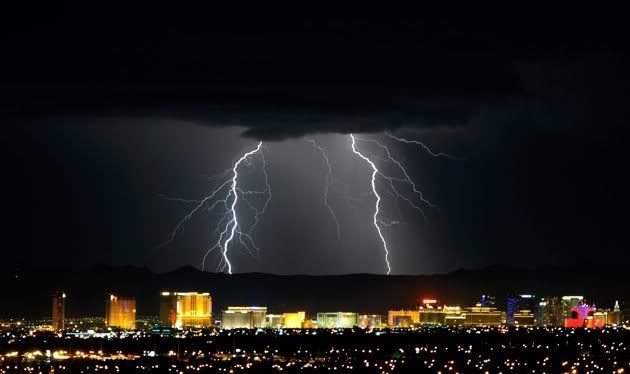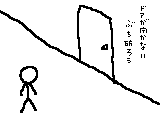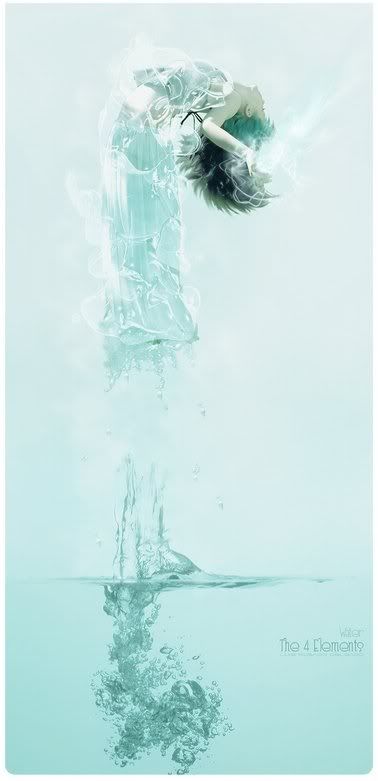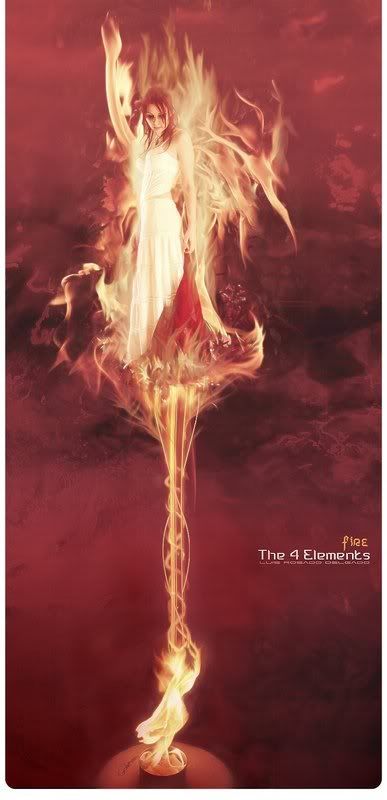Wednesday, September 21, 2011
Amazing Timelapse of Earth
Science educator James Drake built this amazing timelapse video from the perspective of the International Space Station as it flew over North and South America.
He created this video by downloading a series of 600 photographs that were available online at the Gateway to Astronomy Photograph of Earth, and then stitching them together into a complete video.
Amazing volcanic activity seen from space
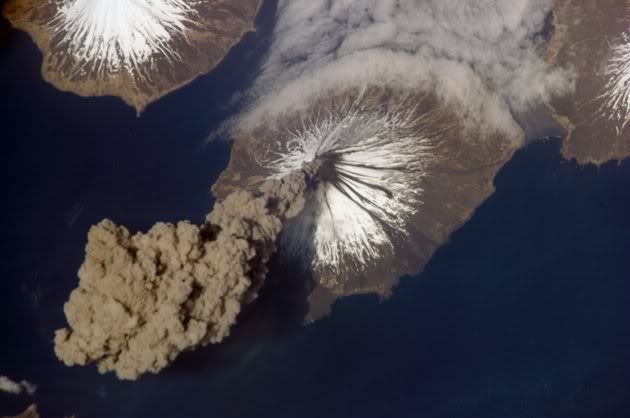
This May 23, 2006, photo released by NASA shows the eruption of Cleveland Volcano, Aleutian Islands, Alaska, as photographed by an Expedition 13 crew member on the International Space Station. The image captures the ash plume of the very short-lived eruption.
Photo Courtesy of Earth Sciences and Image Analysis Laboratory, NASA Johnson Space Center
Japanese girl delighted by bottle found in Hawaii
By MARI YAMAGUCHI , Sep 18, 2011
TOKYO (AP) — A Japanese teenager expressed her gratitude Sunday after a U.S. sailor in Hawaii found a bottle she had tossed into the sea off Japan's southern coast as a child, and said she was delighted to be reconnected with her old classmates as a result.
Saki Arikawa, 17, said she had almost forgotten about the bottle and initially couldn't believe it was found after five years.
In a telephone interview with The Associated Press from her hometown in Kagoshima, she said "it's a miracle" the bottle was found. "It's incredible," she said.
The clear glass bottle was found Thursday by Navy Petty Officer Jon Moore during a beach cleanup at the Pacific Missile Range Facility on Kauai island.
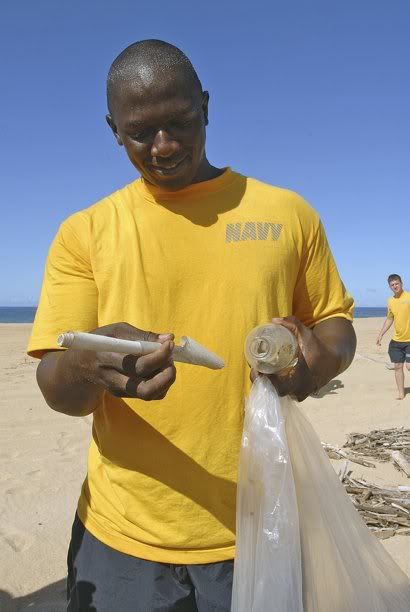
~ U.S. Navy electrician's Mate 2nd Class Jon Moore removes a message from a bottle sent from Kagoshima, Japan more than five years ago
The bottle contained four origami cranes — symbols of peace in Japan — as well as a photo of Arikawa's elementary school class and a note dated March 25, 2006, and signed by Arikawa saying she wanted it to be "a graduation memory."
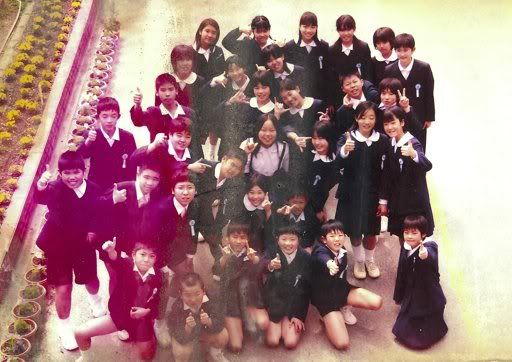
~ A photo of 6th grade students from Kagoshima, Japan found in a bottle by Petty Officer Jon Moore during a cleanup on a beach at the Pacific Missile Range Facility on Kauai Island
News of the bottle's recovery reconnected more than a dozen of her old classmates, now studying at different high schools, and their elementary school homeroom teacher for a reunion Saturday. Arikawa says she now wants to further expand the circle of friendship.
"Thanks to the bottle, some of us could get together and had a great time," she said. "Now I'd like to meet the person who kindly saved my bottle."
The bottle was one of five she tossed into the ocean in 2006 as her sixth-grade class graduated from Kokubu Elementary School in Kagoshima. She and her 31 classmates dropped five bottles each, including the one that turned up last week.
Three other bottles had previously been recovered, including two in Alaska and a third at another location in Hawaii.
The Navy said Moore was among 40 base personnel and 16 students and faculty from a Kauai school who picked up beach trash in observance of International Coastal Cleanup Day.
TOKYO (AP) — A Japanese teenager expressed her gratitude Sunday after a U.S. sailor in Hawaii found a bottle she had tossed into the sea off Japan's southern coast as a child, and said she was delighted to be reconnected with her old classmates as a result.
Saki Arikawa, 17, said she had almost forgotten about the bottle and initially couldn't believe it was found after five years.
In a telephone interview with The Associated Press from her hometown in Kagoshima, she said "it's a miracle" the bottle was found. "It's incredible," she said.
The clear glass bottle was found Thursday by Navy Petty Officer Jon Moore during a beach cleanup at the Pacific Missile Range Facility on Kauai island.

~ U.S. Navy electrician's Mate 2nd Class Jon Moore removes a message from a bottle sent from Kagoshima, Japan more than five years ago
The bottle contained four origami cranes — symbols of peace in Japan — as well as a photo of Arikawa's elementary school class and a note dated March 25, 2006, and signed by Arikawa saying she wanted it to be "a graduation memory."

~ A photo of 6th grade students from Kagoshima, Japan found in a bottle by Petty Officer Jon Moore during a cleanup on a beach at the Pacific Missile Range Facility on Kauai Island
News of the bottle's recovery reconnected more than a dozen of her old classmates, now studying at different high schools, and their elementary school homeroom teacher for a reunion Saturday. Arikawa says she now wants to further expand the circle of friendship.
"Thanks to the bottle, some of us could get together and had a great time," she said. "Now I'd like to meet the person who kindly saved my bottle."
The bottle was one of five she tossed into the ocean in 2006 as her sixth-grade class graduated from Kokubu Elementary School in Kagoshima. She and her 31 classmates dropped five bottles each, including the one that turned up last week.
Three other bottles had previously been recovered, including two in Alaska and a third at another location in Hawaii.
The Navy said Moore was among 40 base personnel and 16 students and faculty from a Kauai school who picked up beach trash in observance of International Coastal Cleanup Day.
Tuesday, September 20, 2011
200-year-old letter by Raffles on Singpore
By Philip Lim @ 19/9/2011
A nearly illegible letter from almost two centuries ago is kept in a dim, cold room in downtown Singapore accessible only to a privileged few via an electronic swipe card.
In flowing script dated June 9, 1819, Singapore's colonial founder Stamford Raffles described the island's formative days as a regional trading port in the Malay archipelago, and it turned out to be prophetic.
"The Settlement I had the satisfaction to form in this very centrical and commanding station has had every success ... our Port is already crowded with shipping from all the native Ports in the Archipelago," he wrote.

~ letters from centuries ago displayed in a room that is home to the Rare Materials Collection (RMC) of Singapore's National Library.
The letter, as well as some 7,000 other items in the room, form the Rare Materials Collection (RMC) of Singapore's National Library, offering a more intimate look into the past of what is now one of the world's busiest ports.
"The history textbook doesn't cover everything," senior librarian Ong Eng Chuan told an AFP reporter who was allowed briefly into the chamber.
"The RMC gives you an interesting perspective of Singapore, from a small fishing village to an international trading port," Ong told AFP.
"It offers an interesting window for the generation now to look into Singapore, and how it has developed into the current place that it is now."
Stepping into the RMC may seem rather underwhelming at first as nondescript boxes containing books and documents sit neatly on shelves with no indication of their historical importance.
The boxes -- made from acid-free paper -- as well as the 18-20 degree celsius (64-68 degree Fahrenheit) temperature, 50-55 percent humidity and dim lighting are necessary to prevent the collection from degrading, Ong said.
People allowed to handle the documents have to wear gloves.
"Some of our hands might have sweat, and the moisture is not good for the paper," he said.

~Senior librarian Ong Eng Chuan flipping through the pages of old newspaper Syonan Sinbun, on display in the Rare Materials Collection (RMC) of Singapore's National Library
Physical access to the RMC is strictly limited on a "case-by-case basis," with librarians routinely referring people asking to view the collection to digital versions posted on the library's website.
Anyone asking to see the real collection needs a pretty good reason.
"Seeing the actual item has an X factor that can make it more interesting for the people, but we have to balance the need to preserve the item and the need to provide access to the content," Ong said.
Publications kept by the RMC include European travelogues from as early as 1577, biographical accounts of daily life in Malaya and even love poems and cookbooks from a hundred years ago.
"The Mem's Own Cookery Book" -- meant for the wives of British administrators who established colonies around Asia at the time -- features recipes to suit the tastebuds of homesick Englishmen.
Recipes for spinach soup, roast hare and pigeon mingle with tips for more adventurous fare like jungle deer curry and sheep head broth.
In contrast, the "Hikayat Abdullah," an 1849 biography of the father of modern Malay literature Munshi Abdullah, offered a unique perspective often missing from records largely penned by Western authors, librarian Ong said.
"It offers an Asian perspective in contrast to the accounts you see from the East India company's records and the memoirs written by those officials," he stated.
In the biography, Abdullah praises Raffles -- who had employed him as a translator -- but offered a less than complimentary description of British sailors who docked in his hometown Malacca, now part of Malaysia.
"To see an Englishman was like seeing a tiger, because they were so mischievous and violent... At that time I never met an Englishman who had a white face, for all of them had 'mounted the green horse', that is to say, were drunk," he wrote.
"So much so that when children cried their mothers would say, 'Be quiet, the drunken Englishman is coming,' and the children would be scared, and keep quiet."
John Solomon, a postgraduate student from Australia's University of New South Wales, accessed the RMC twice for his research on 19th-century transmarine convicts sent to Singapore.
"As a historian, I enjoy being able to physically handle material from the period. It gives the past this powerful sense of immediacy and presence," he said.
"Being in contact with the physical material also makes me realise that Singapore's story is not merely an account of economic and social policies but is also enmeshed in the everyday struggles and triumphs of individuals from vastly different circumstances."
A nearly illegible letter from almost two centuries ago is kept in a dim, cold room in downtown Singapore accessible only to a privileged few via an electronic swipe card.
In flowing script dated June 9, 1819, Singapore's colonial founder Stamford Raffles described the island's formative days as a regional trading port in the Malay archipelago, and it turned out to be prophetic.
"The Settlement I had the satisfaction to form in this very centrical and commanding station has had every success ... our Port is already crowded with shipping from all the native Ports in the Archipelago," he wrote.

~ letters from centuries ago displayed in a room that is home to the Rare Materials Collection (RMC) of Singapore's National Library.
The letter, as well as some 7,000 other items in the room, form the Rare Materials Collection (RMC) of Singapore's National Library, offering a more intimate look into the past of what is now one of the world's busiest ports.
"The history textbook doesn't cover everything," senior librarian Ong Eng Chuan told an AFP reporter who was allowed briefly into the chamber.
"The RMC gives you an interesting perspective of Singapore, from a small fishing village to an international trading port," Ong told AFP.
"It offers an interesting window for the generation now to look into Singapore, and how it has developed into the current place that it is now."
Stepping into the RMC may seem rather underwhelming at first as nondescript boxes containing books and documents sit neatly on shelves with no indication of their historical importance.
The boxes -- made from acid-free paper -- as well as the 18-20 degree celsius (64-68 degree Fahrenheit) temperature, 50-55 percent humidity and dim lighting are necessary to prevent the collection from degrading, Ong said.
People allowed to handle the documents have to wear gloves.
"Some of our hands might have sweat, and the moisture is not good for the paper," he said.

~Senior librarian Ong Eng Chuan flipping through the pages of old newspaper Syonan Sinbun, on display in the Rare Materials Collection (RMC) of Singapore's National Library
Physical access to the RMC is strictly limited on a "case-by-case basis," with librarians routinely referring people asking to view the collection to digital versions posted on the library's website.
Anyone asking to see the real collection needs a pretty good reason.
"Seeing the actual item has an X factor that can make it more interesting for the people, but we have to balance the need to preserve the item and the need to provide access to the content," Ong said.
Publications kept by the RMC include European travelogues from as early as 1577, biographical accounts of daily life in Malaya and even love poems and cookbooks from a hundred years ago.
"The Mem's Own Cookery Book" -- meant for the wives of British administrators who established colonies around Asia at the time -- features recipes to suit the tastebuds of homesick Englishmen.
Recipes for spinach soup, roast hare and pigeon mingle with tips for more adventurous fare like jungle deer curry and sheep head broth.
In contrast, the "Hikayat Abdullah," an 1849 biography of the father of modern Malay literature Munshi Abdullah, offered a unique perspective often missing from records largely penned by Western authors, librarian Ong said.
"It offers an Asian perspective in contrast to the accounts you see from the East India company's records and the memoirs written by those officials," he stated.
In the biography, Abdullah praises Raffles -- who had employed him as a translator -- but offered a less than complimentary description of British sailors who docked in his hometown Malacca, now part of Malaysia.
"To see an Englishman was like seeing a tiger, because they were so mischievous and violent... At that time I never met an Englishman who had a white face, for all of them had 'mounted the green horse', that is to say, were drunk," he wrote.
"So much so that when children cried their mothers would say, 'Be quiet, the drunken Englishman is coming,' and the children would be scared, and keep quiet."
John Solomon, a postgraduate student from Australia's University of New South Wales, accessed the RMC twice for his research on 19th-century transmarine convicts sent to Singapore.
"As a historian, I enjoy being able to physically handle material from the period. It gives the past this powerful sense of immediacy and presence," he said.
"Being in contact with the physical material also makes me realise that Singapore's story is not merely an account of economic and social policies but is also enmeshed in the everyday struggles and triumphs of individuals from vastly different circumstances."
Monday, September 19, 2011
Japanese Tsunami Viewed From A Car
Yu Muroga is a Japanese driver. It was his tour took place when the earthquake March 11, 2011. Like most people of his area, he did not feel threatened by the tsumani, as it was far enough from the coast. So he continued to drive and do its job. The HD camera mounted on the dashboard has not only captured the shock but also the moments that followed, where many drivers were stranded by the waters of the tsunami.
Note : The "Dancing" man at the road junction is due to EARTHQUAKE (ground shaking)
Note : The "Dancing" man at the road junction is due to EARTHQUAKE (ground shaking)
Visible Only From Above, Mystifying 'Nazca Lines' Discovered in Mideast
By Owen Jarus | LiveScience.com – Thu, Sep 15, 2011
The giant stone structures form wheel shapes with spokes often radiating inside. Here a cluster of wheels in the Azraq Oasis. CREDIT: David D. Boyer
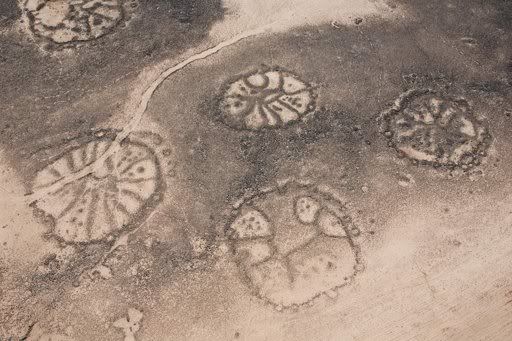
They stretch from Syria to Saudi Arabia, can be seen from the air but not the ground, and are virtually unknown to the public.
They are the Middle East's own version of the Nazca Lines — ancient "geolyphs," or drawings, that span deserts in southern Peru — and now, thanks to new satellite-mapping technologies, and an aerial photography program in Jordan, researchers are discovering more of them than ever before. They number well into the thousands.
Referred to by archaeologists as "wheels," these stone structures have a wide variety of designs, with a common one being a circle with spokes radiating inside. Researchers believe that they date back to antiquity, at least 2,000 years ago. They are often found on lava fields and range from 82 feet to 230 feet (25 meters to 70 meters) across. [See gallery of wheel structures]
"In Jordan alone we've got stone-built structures that are far more numerous than (the) Nazca Lines, far more extensive in the area that they cover, and far older," said David Kennedy, a professor of classics and ancient history at the University of Western Australia.
Kennedy's new research, which will be published in a forthcoming issue of the Journal of Archaeological Science, reveals that these wheels form part of a variety of stone landscapes. These include kites (stone structures used for funnelling and killing animals); pendants (lines of stone cairns that run from burials); and walls, mysterious structures that meander across the landscape for up to several hundred feet and have no apparent practical use.
His team's studies are part of a long-term aerial reconnaissance project that is looking at archaeological sites across Jordan. As of now, Kennedy and his colleagues are puzzled as to what the structures may have been used for or what meaning they held. [History's Most Overlooked Mysteries]
Fascinating structures
Kennedy's main area of expertise is in Roman archaeology, but he became fascinated by these structures when, as a student, he read accounts of Royal Air Force pilots flying over them in the 1920s on airmail routes across Jordan. "You can't not be fascinated by these things," Kennedy said.
Indeed, in 1927 RAF Flight Lt. Percy Maitland published an account of the ruins in the journal Antiquity. He reported encountering them over "lava country" and said that they, along with the other stone structures, are known to the Bedouin as the "works of the old men."
Kennedy and his team have been studying the structures using aerial photography and Google Earth, as the wheels are hard to pick up from the ground, Kennedy said.
"Sometimes when you're actually there on the site you can make out something of a pattern but not very easily," he said. "Whereas if you go up just a hundred feet or so it, for me, comes sharply into focus what the shape is."
The designs must have been clearer when they were originally built. "People have probably walked over them, walked past them, for centuries, millennia, without having any clear idea what the shape was."
(The team has created an archive of images of the wheels from various sites in the Middle East.)
What were they used for ?
So far, none of the wheels appears to have been excavated, something that makes dating them, and finding out their purpose, more difficult. Archaeologists studying them in the pre-Google Earth era speculated that they could be the remains of houses or cemeteries. Kennedy said that neither of these explanations seems to work out well.
"There seems to be some overarching cultural continuum in this area in which people felt there was a need to build structures that were circular."
Some of the wheels are found in isolation while others are clustered together. At one location, near the Azraq Oasis, hundreds of them can be found clustered into a dozen groups. "Some of these collections around Azraq are really quite remarkable," Kennedy said.
In Saudi Arabia, Kennedy's team has found wheel styles that are quite different: Some are rectangular and are not wheels at all; others are circular but contain two spokes forming a bar often aligned in the same direction that the sun rises and sets in the Middle East.
The ones in Jordan and Syria, on the other hand, have numerous spokes and do not seem to be aligned with any astronomical phenomena. "On looking at large numbers of these, over a number of years, I wasn't struck by any pattern in the way in which the spokes were laid out," Kennedy said.
Cairns are often found associated with the wheels. Sometimes they circle the perimeter of the wheel, other times they are in among the spokes. In Saudi Arabia some of the cairns look, from the air, like they are associated with ancient burials.
Dating the wheels is difficult, since they appear to be prehistoric, but could date to as recently as 2,000 years ago. The researchers have noted that the wheels are often found on top of kites, which date as far back as 9,000 years, but never vice versa. "That suggests that wheels are more recent than the kites," Kennedy said.
Amelia Sparavigna, a physics professor at Politecnico di Torino in Italy, told Live Science in an email that she agrees these structures can be referred to as geoglyphs in the same way as the Nazca Lines are. "If we define a 'geoglyph' as a wide sign on the ground of artificial origin, the stone circles are geoglyphs," Sparavignawrote in her email.
The function of the wheels may also have been similar to the enigmatic drawings in the Nazca desert. [Science as Art: A Gallery]
"If we consider, more generally, the stone circles as worship places of ancestors, or places for rituals connected with astronomical events or with seasons, they could have the same function of [the] geoglyphs of South America, the Nazca Lines for instance. The design is different, but the function could be the same," she wrote in her email.
Kennedy said that for now the meaning of the wheels remains a mystery. "The question is what was the purpose?"
The giant stone structures form wheel shapes with spokes often radiating inside. Here a cluster of wheels in the Azraq Oasis. CREDIT: David D. Boyer

They stretch from Syria to Saudi Arabia, can be seen from the air but not the ground, and are virtually unknown to the public.
They are the Middle East's own version of the Nazca Lines — ancient "geolyphs," or drawings, that span deserts in southern Peru — and now, thanks to new satellite-mapping technologies, and an aerial photography program in Jordan, researchers are discovering more of them than ever before. They number well into the thousands.
Referred to by archaeologists as "wheels," these stone structures have a wide variety of designs, with a common one being a circle with spokes radiating inside. Researchers believe that they date back to antiquity, at least 2,000 years ago. They are often found on lava fields and range from 82 feet to 230 feet (25 meters to 70 meters) across. [See gallery of wheel structures]
"In Jordan alone we've got stone-built structures that are far more numerous than (the) Nazca Lines, far more extensive in the area that they cover, and far older," said David Kennedy, a professor of classics and ancient history at the University of Western Australia.
Kennedy's new research, which will be published in a forthcoming issue of the Journal of Archaeological Science, reveals that these wheels form part of a variety of stone landscapes. These include kites (stone structures used for funnelling and killing animals); pendants (lines of stone cairns that run from burials); and walls, mysterious structures that meander across the landscape for up to several hundred feet and have no apparent practical use.
His team's studies are part of a long-term aerial reconnaissance project that is looking at archaeological sites across Jordan. As of now, Kennedy and his colleagues are puzzled as to what the structures may have been used for or what meaning they held. [History's Most Overlooked Mysteries]
Fascinating structures
Kennedy's main area of expertise is in Roman archaeology, but he became fascinated by these structures when, as a student, he read accounts of Royal Air Force pilots flying over them in the 1920s on airmail routes across Jordan. "You can't not be fascinated by these things," Kennedy said.
Indeed, in 1927 RAF Flight Lt. Percy Maitland published an account of the ruins in the journal Antiquity. He reported encountering them over "lava country" and said that they, along with the other stone structures, are known to the Bedouin as the "works of the old men."
Kennedy and his team have been studying the structures using aerial photography and Google Earth, as the wheels are hard to pick up from the ground, Kennedy said.
"Sometimes when you're actually there on the site you can make out something of a pattern but not very easily," he said. "Whereas if you go up just a hundred feet or so it, for me, comes sharply into focus what the shape is."
The designs must have been clearer when they were originally built. "People have probably walked over them, walked past them, for centuries, millennia, without having any clear idea what the shape was."
(The team has created an archive of images of the wheels from various sites in the Middle East.)
What were they used for ?
So far, none of the wheels appears to have been excavated, something that makes dating them, and finding out their purpose, more difficult. Archaeologists studying them in the pre-Google Earth era speculated that they could be the remains of houses or cemeteries. Kennedy said that neither of these explanations seems to work out well.
"There seems to be some overarching cultural continuum in this area in which people felt there was a need to build structures that were circular."
Some of the wheels are found in isolation while others are clustered together. At one location, near the Azraq Oasis, hundreds of them can be found clustered into a dozen groups. "Some of these collections around Azraq are really quite remarkable," Kennedy said.
In Saudi Arabia, Kennedy's team has found wheel styles that are quite different: Some are rectangular and are not wheels at all; others are circular but contain two spokes forming a bar often aligned in the same direction that the sun rises and sets in the Middle East.
The ones in Jordan and Syria, on the other hand, have numerous spokes and do not seem to be aligned with any astronomical phenomena. "On looking at large numbers of these, over a number of years, I wasn't struck by any pattern in the way in which the spokes were laid out," Kennedy said.
Cairns are often found associated with the wheels. Sometimes they circle the perimeter of the wheel, other times they are in among the spokes. In Saudi Arabia some of the cairns look, from the air, like they are associated with ancient burials.
Dating the wheels is difficult, since they appear to be prehistoric, but could date to as recently as 2,000 years ago. The researchers have noted that the wheels are often found on top of kites, which date as far back as 9,000 years, but never vice versa. "That suggests that wheels are more recent than the kites," Kennedy said.
Amelia Sparavigna, a physics professor at Politecnico di Torino in Italy, told Live Science in an email that she agrees these structures can be referred to as geoglyphs in the same way as the Nazca Lines are. "If we define a 'geoglyph' as a wide sign on the ground of artificial origin, the stone circles are geoglyphs," Sparavignawrote in her email.
The function of the wheels may also have been similar to the enigmatic drawings in the Nazca desert. [Science as Art: A Gallery]
"If we consider, more generally, the stone circles as worship places of ancestors, or places for rituals connected with astronomical events or with seasons, they could have the same function of [the] geoglyphs of South America, the Nazca Lines for instance. The design is different, but the function could be the same," she wrote in her email.
Kennedy said that for now the meaning of the wheels remains a mystery. "The question is what was the purpose?"
Massive 20m deep crater opens up in German town

An aerial view of a large crater that appeared in the early hours in the central German town of Schmalkalden, November 1, 2010. A huge crater measuring 30 by 40 metres (98 by 131 feet ) has opened up in the middle of a residential estate early in the morning on Monday, according to local police. No one was reported hurt in the incident

Residents in the German town of Schmalkalden probably had the shock of their lives when they opened their bedroom curtains as a giant crater had formed overnight.
There is no injuries but forcing the evacuation of 25 people.This huge hole caused by landslide or impact by meteor hit ? The experts are now still investigating..


Subscribe to:
Posts (Atom)

